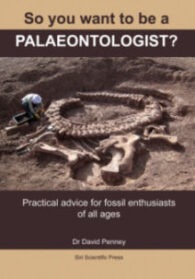By David Penney

In these times, when the classic discipline of palaeontology is diminishing, there is a demanding need to inspire the next generation of palaeontologists – and perhaps also to make this field of scientific research more approachable. Otherwise, we are in the risk of losing generations of knowhow and a great tradition of studying time, through the evolution of life.
In that sense, So you want to be a palaeontologist?, a recent volume on the world of palaeontologists, by the widely acclaimed researcher and palaeontologist, Dr David Penney (Honorary Lecturer at University of Manchester) presents a fitting hymn to the study of fossils. This is set out as a more personal account – and evidently the result of a great passion for fossils and palaeontology – and the book is also very welcome practical advice on to how to pursue a career as a palaeontologist and what it may mean.
Using a wide selection of images related to palaeontology, including photos, technical drawings and figures, Penney makes the content of the book easier accessible – in a more abstract sense – thereby providing a clear picture of the great variety of fields palaeontologists work within. It also emphasises that palaeontology is – or should be – one of the strongest scientific disciplines.
Coming from a country, where only around a handful of people are working professionally with palaeontology as their core topic, I think there is a great need for broadening the knowledge of palaeontology, and therefore there may also be a real need for such a book. In fact, it really is an easy must-read for the aspiring palaeontologist and, coming in the size of a booklet or field guide, at a fairly reasonable price, this book should be in permanent stock at all libraries, and in my view, especially in school libraries. This is because I think there is a small palaeontologist hidden in all of us, but it is more evident in the younger generations.
So you want to be a Palaeontologist? Practical advice for fossil enthusiasts of all ages, by Dr David Penney, Siri Scientific Press, Manchester, UK (2016), 64 pages (paperback), ISBN: 978-09-92997-96-0


